You probably already know about the importance of email marketing for eCommerce. But how exactly do you write winning emails that get contacts shopping with you?
In this regard, many other resources out there will talk about how your emails need to have compelling subject lines! And smart copy! And flashy pictures! While that’s all well and good, these guides fail to mention one crucial thing:
Your eCommerce emails need to have a purpose.
In other words, what are you emailing your contacts for? If this isn’t clear from the outset, your contacts may think you’re wasting your time and immediately delete your email. No matter how prettily designed it is. 😢
So with this in mind, we’re going to cover the 15 best eCommerce email examples you can swipe for your own store emails—plus their all-important purpose.
By browsing through these emails, you’ll know your objective for sending them and what they can get you if you put them together well. And as a bonus, we’ll also share some quick tips on how you can write creative emails for eCommerce!
15 Top eCommerce email examples to boost sales
1. Abandoned cart emails
Abandoned cart emails are emails that remind customers of their abandoned carts and ask if they are still interested in placing their order. Such as this one by Chatters, for example:
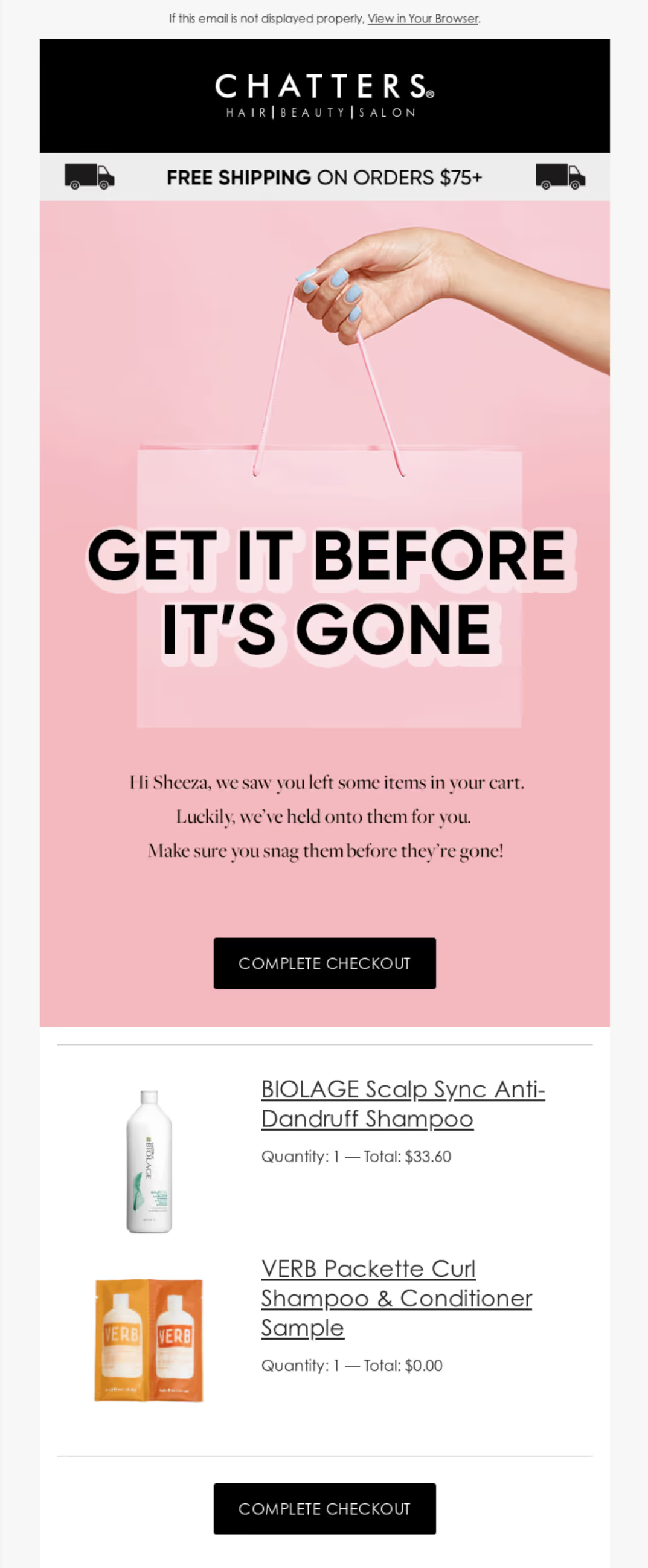
Why use abandoned cart emails?
By reminding customers of their incomplete order, abandoned cart emails try to rescue the sale—and hence the revenue you might otherwise lose.
For greater effectiveness, you can also pair abandoned cart emails with abandoned cart SMSes! Our help article on how to retarget abandoned carts with email and SMS shares further info on this if you’d like to learn more.
2. Browse abandonment emails
If abandoned cart emails are meant for customers who have abandoned their cart, then browse abandonment emails are for users who have abandoned the browsing of your store.
In other words, they visited your site, then left without buying anything. (You’d call such users window-shoppers IRL.)
Here’s an example of a browse abandonment email, courtesy of Timberland:
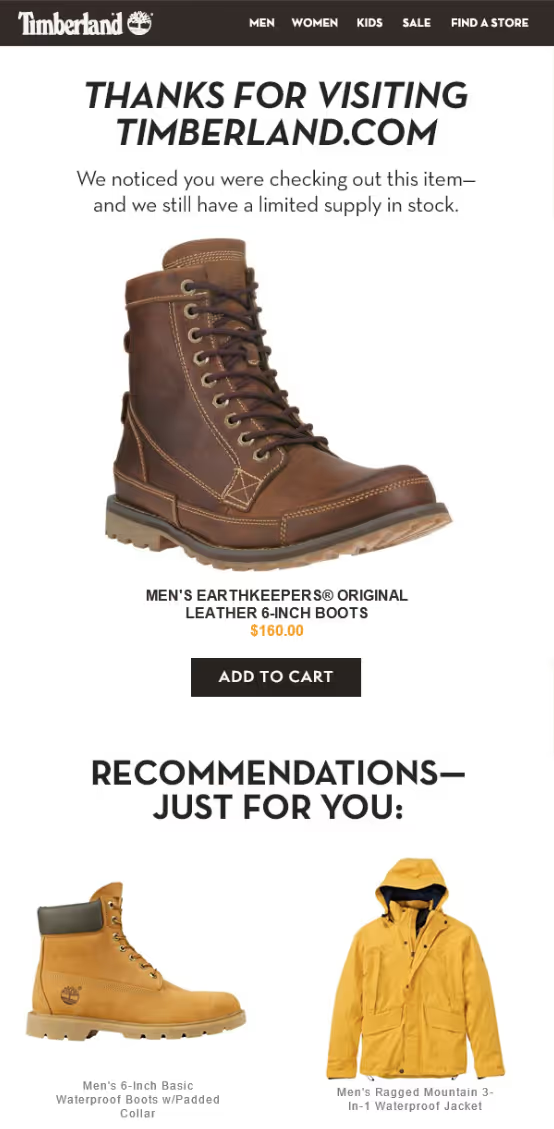
Why use browse abandonment emails?
Browse abandonment emails help re-engage casual website visitors of your store, even if they haven’t shown more serious buying intent yet (such as by adding items to their cart).
You never know, your email may just provide the extra nudge the visitor needs to check out your items more closely. Maybe even buy them!
3. New subscriber/customer welcome emails
Did new subscribers join your email list? Then it’s time to roll out the red carpet and receive them with a welcome email!
Just take this welcome email from GoPro.
With wording such as “now you’ll be the first to know,” the email makes email subscribers feel as if they’ve joined an exclusive club.
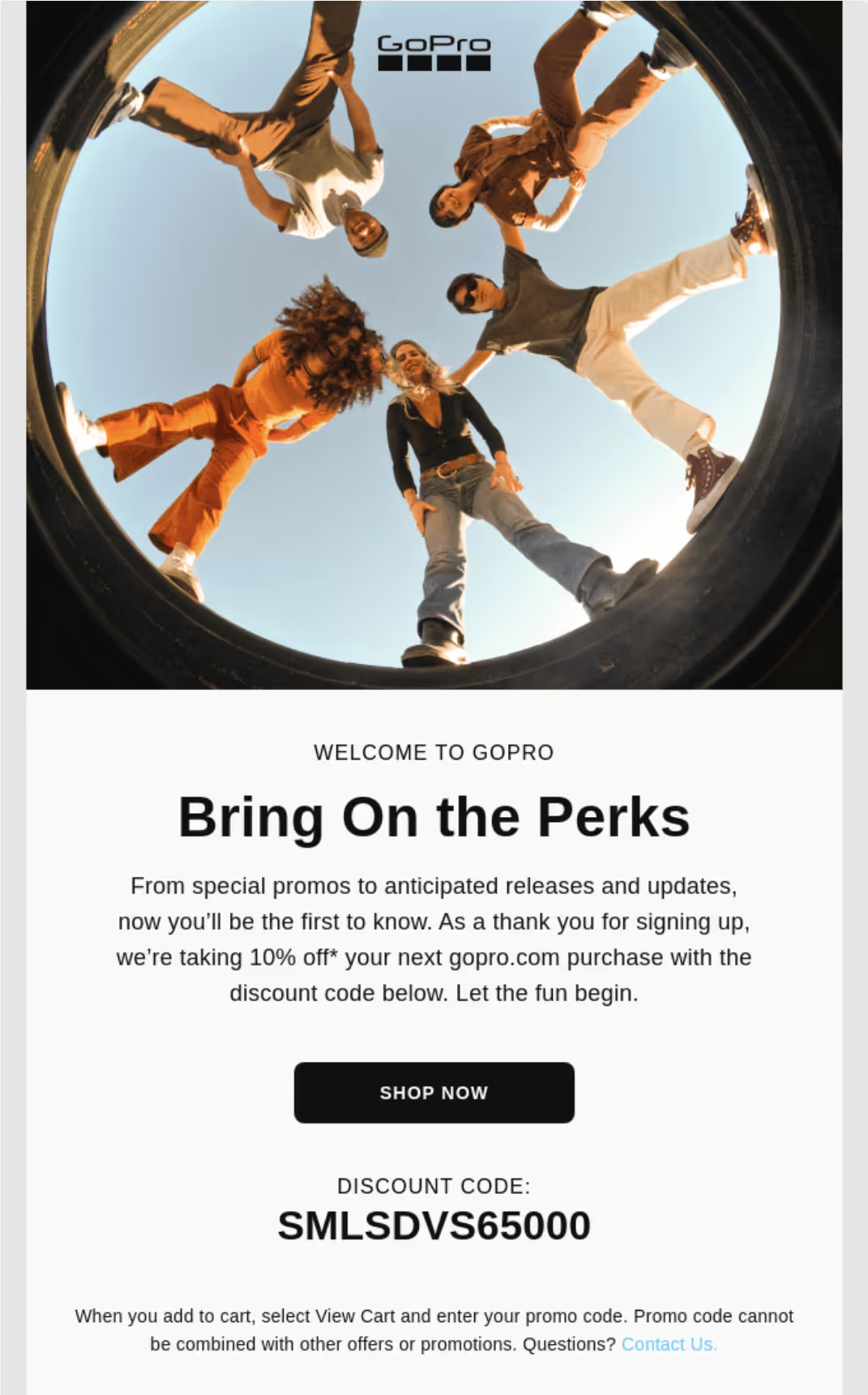
Why use new subscriber/customer welcome emails?
When a new subscriber has become a part of your community, sending a welcome email gives you the chance to acquaint them with your brand. Doing so can build customer goodwill that leads to brand loyalty—and more sales!—over time.
That said, you don’t have to wait to start making sales. In your welcome email, you can include a discount code to entice customers to start shopping with you right away!
(Case in point: see the GoPro email above. 😎)
4. Up-sell emails
Think of up-sell emails as emails that try to “level up” a sale. They pitch products that are an upgrade from a product a customer had been looking at, or that they’ve already bought.
For instance, the “Grab More Goodies Here” section of this email by BLUME recommends latte bundle packs—which is a step up from buying just a single pack!

Why use up-sell emails?
While customers may already have their heart set on buying a particular product, you might offer an even better version of this product that they may want instead. The only problem? They don’t know such a product exists.
Up-sell emails therefore help you raise awareness of such products for the customer’s consideration. And if they do decide to buy your up-sell, then you’ll have increased their average order value!
5. Cross-sell emails
Cross-sell emails pitch products that are complementary to products a customer is interested in, or has just bought.
So in that sense, they’re similar to up-sell emails. Only that the products you push in cross-sell emails tend to be those that pair well—and are meant to be used together—with the original product.
This email from BÉIS below provides an excellent example of a cross-sell email. It recommends relevant luggage accessories, and customers receive it when they purchase luggage from the brand.

Why use cross-sell emails?
Just like up-sell emails, cross-sell emails can persuade customers to buy more from you. This in turn increases their average order values.
After all, they’re already getting some stuff from you. So why not add a couple more items that they also need, for the convenience of it?
6. Referral program emails
If you have a referral program in place for your store, then publicize it with a referral program email!
Such referral emails encourage existing customers to promote a brand’s products to their family and friends. In return, they’ll receive a reward if the family member or friend goes on to buy from the brand.
Here, this referral program email from Blenders advertises how customers who join its “Motion” referral program can get $20 for every successful referral:

Why use referral program emails?
Referral program emails enlist your customers’ help in spreading the word about your brand. Your customers will scour their network for people who may be interested in your products, then promote these products to such people on your behalf.
If their pitch is successful, you’ll earn more sales as their family and friends buy from you. 💰
And even if they decide not to buy from you now, you’ll still have raised awareness of your store. This brand awareness will come in handy if they need your products down the road!
7. Loyalty program emails
If customers regularly shop with you, reward their loyalty by offering them membership to your loyalty program. Just send a loyalty program email their way so they find out about it!
For inspiration, check out this cool loyalty program email by Native:

The brand’s loyalty program has different tiers of benefits. (The tier mentioned in this email, “Cucumber Connoisseur,” entitles the customer to early access to sales, for example.)
By taking certain actions, such as ordering from Native or following the brand on its socials, customers can climb the loyalty tiers and earn points. They can also accumulate these points to get a discount on their next order!
Why use loyalty program emails?
Loyalty program emails advertise how you reward your regulars with freebies and exclusive benefits. Such customers will not only feel like VIPs, but also be encouraged to continue shopping with you (to take advantage of the perks you’ve showered them with).
The end result is higher retention, further purchases, and more sales for you!
8. Survey emails
What do customers think of your brand and products? Sending a survey email to get their feedback is the perfect way of finding out.
Such feedback could relate to their:
- recent order,
- general shopping experience with you,
- customer support interaction, tor even their
- thoughts on upcoming products.
Anything that you want to know your customers’ opinions on, really!
Here, Gainful has sent this survey email to learn their customer’s thoughts on a recent purchase (in exchange for some rewards points):
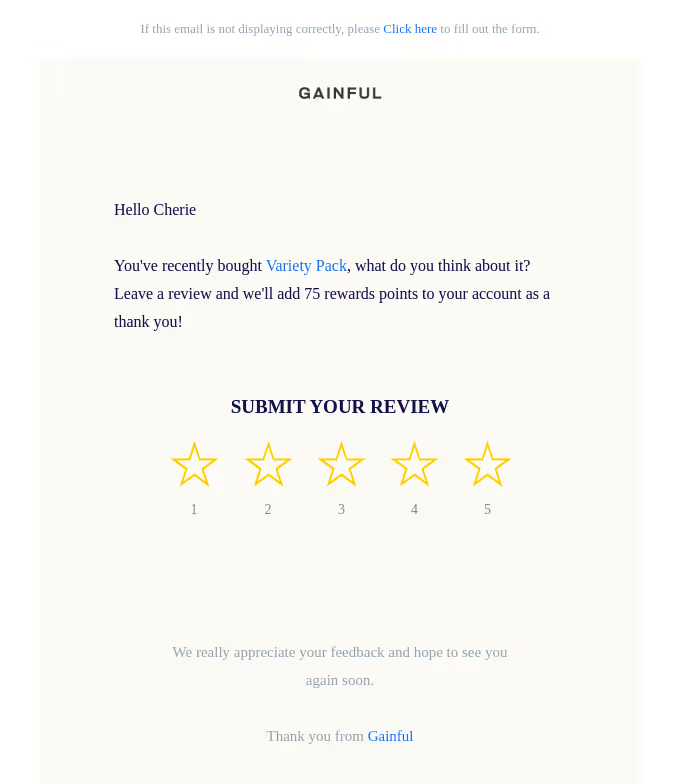
Why use survey emails?
Survey emails help you learn what actual buyers of your products think of them and your brand. Using such feedback, you can work on your customer experience to keep them—and all other customers—coming back to your online store for their needs.
9. Post-purchase emails
As their name suggests, post-purchase emails refer to any type of email you send after a customer makes a purchase. They can include:
- Order acknowledgment emails
- Shipment emails
- Post-purchase product recommendation emails
- Survey emails
This post-purchase email by Crate & Barrel falls within the “order acknowledgment” category of post-purchase emails.
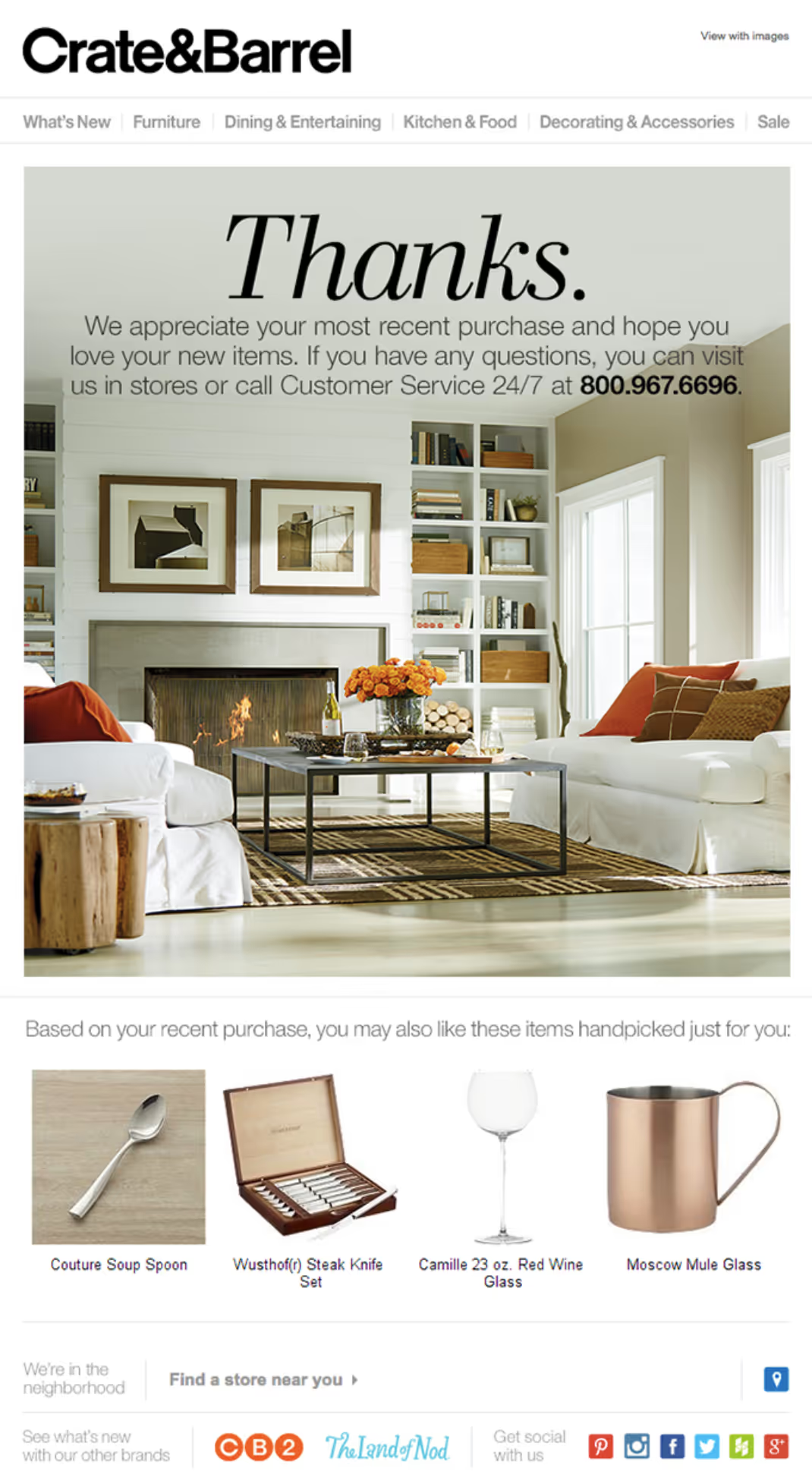
The email thanks the customer for their recent purchase and shares avenues for getting customer service if they need it. It also recommends related products that the customer may want to get next.
Why use post-purchase emails?
The purchase of a product may mark a successful conversion, but don’t let the customer journey end there!
Use post-purchase emails to continue engaging your customer—whether with important order information, requests for customer feedback, or suggestions of other products they may love.
Such extended engagement can help keep customers thinking of you, and coming back to you, for their future needs.
10. Re-engagement emails
Re-engagement emails help re-engage contacts who haven’t engaged with (i.e. opened or clicked) your emails in a while. They ask contacts if they’re still keen on hearing from you, and also encourage them to purchase from you.
The re-engagement email may also include a discount code to incentivize a purchase, like what Dusk has done here:
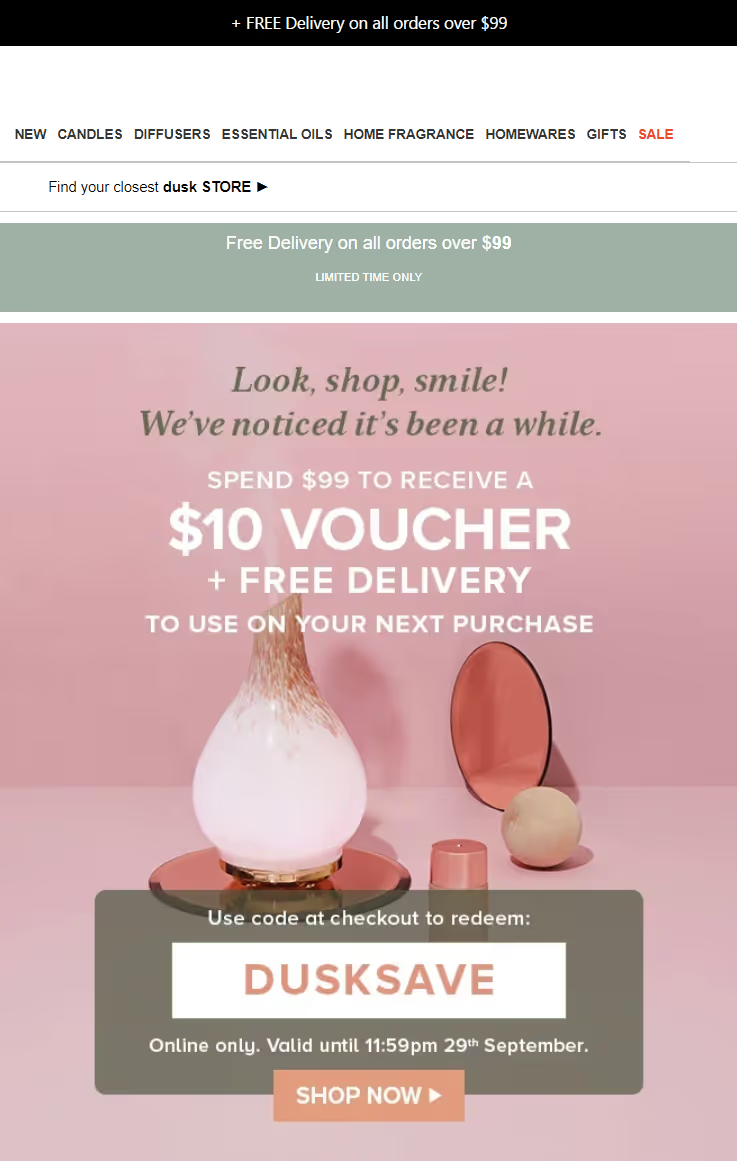
Why use re-engagement emails?
Over time, customers may have lost touch with your brand. Sending a re-engagement email helps put your brand back at the forefront of their memory, so they’ll be reminded of you—and buy from you—if they need something that you offer.
At the same time, you can find out if such customers are still keen on hearing from you. And if they aren’t, you can remove them from your email list. No hard feelings!
Better to scrub such disinterested customers from your email list than continue to send them emails, which could lead to them marking your emails as spam and hurting your sender reputation. 😢
11. Win-back emails
Win-back emails are close cousins of re-engagement emails. While they also attempt to re-engage your contacts, you’ll send these emails to just those who have purchased something from you.
Putting things differently, win-back emails try to help you “win back” your customers’ business! If an unengaged contact on your email list hasn’t purchased from you before, you should be sending them a re-engagement email instead.
This email from Beringer Vineyards provides a good example of a win-back email:

Why use win-back emails?
Like re-engagement emails, win-back emails help jog your contacts’ memory of their relationship with you.
But since these contacts have previously purchased from you, they may have already had a good experience using your products. They’re therefore more likely to buy from you again if you pop up in their inbox!
Apart from this, even if your win-back email indicates that the customer has moved on from your brand, you’ll know this and can safely prune them from your email list.
12. Discount emails
As a customer myself, I’m always happy to get a discount email. Because when I open it, I can expect to see some sweet savings! After that, I can head over to the online store in question and save money as I shop 😍
Depending on your sales strategy, your discount emails can offer discounts for specific product(s) or for everything in your store.
In this discount email, Athletic Brewing handed out a discount code for 35% off one of its products (a Cerveza Atletica brew):

Why use discount emails?
Offering a discount is a proven way of getting people to open their wallets!
Just be smart with how you discount your products, because your increase in sales revenue will need to more than make up for the discounts you gave out.
For example, you could do a steep discount on one product to entice customers to browse your store. Then while they’re there buying your discounted product for cheap, they may be tempted to load up on other items—which increases their average order value with you.
13. Product launch emails
When you launch a product, you’ll want to give it the best chances of success. So this means sending a series of product launch emails to announce your new product!
If you’ve subscribed to Apple’s email list, you might have received promotional emails like this one when the brand was dropping its AirPods Pro earbuds:
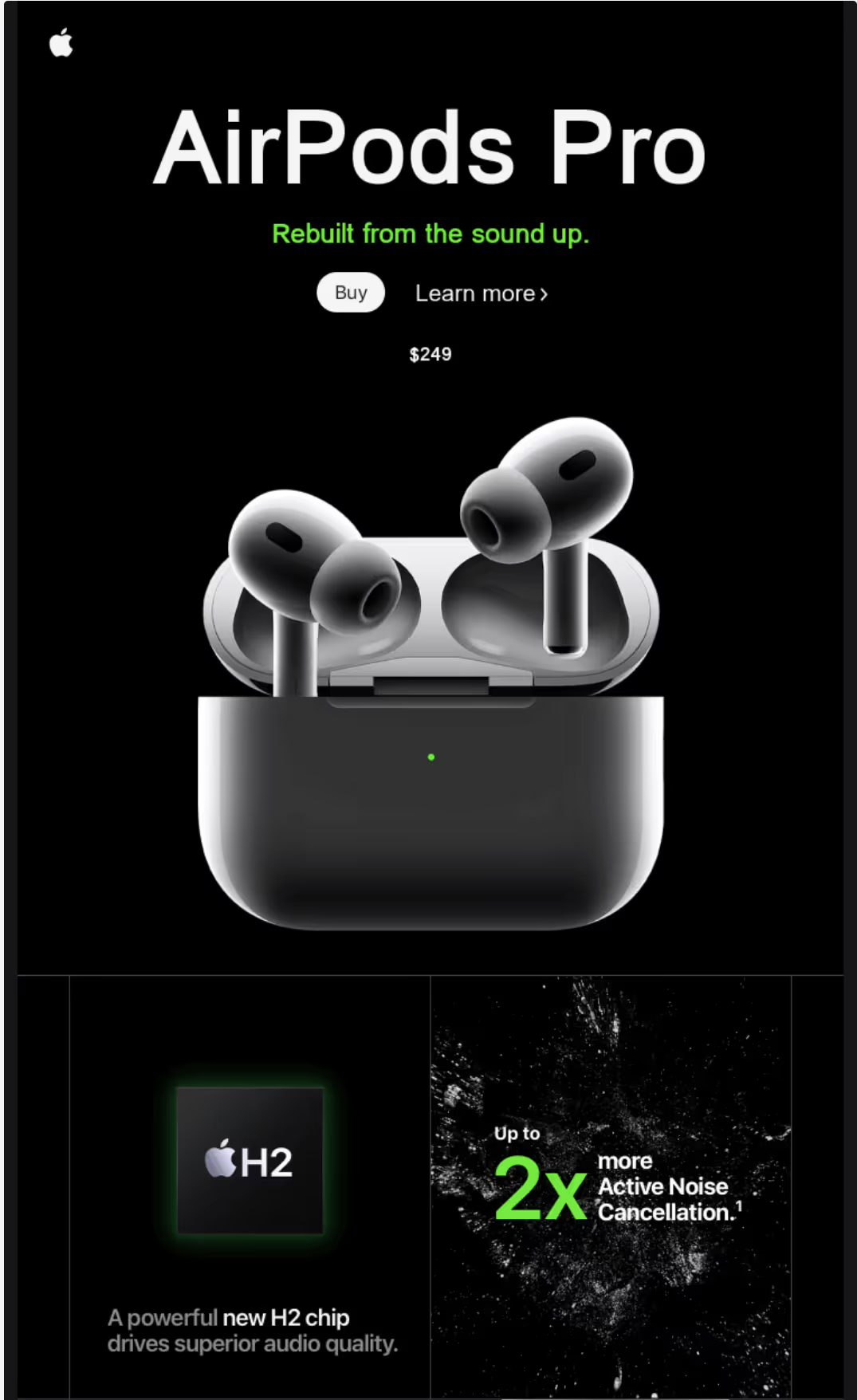
Why use product launch emails?
Product launch emails help you get the word out about your newly launched product. They also inform customers of the product’s features, benefits, and pricing so they can make an informed decision as to whether to buy it.
The result is that you drum up publicity for your product, and potentially bring in more sales too.
14. Anniversary emails
These emails celebrate the anniversary of your brand’s founding—or your brand’s birthday, if you will!
This is a great opportunity to get your customers in on the celebration, too! That’s where your anniversary emails come in to offer special anniversary deals on your products, and get contacts celebrating with you.
Just like how Aquazzura sent this email for its 10th anniversary:
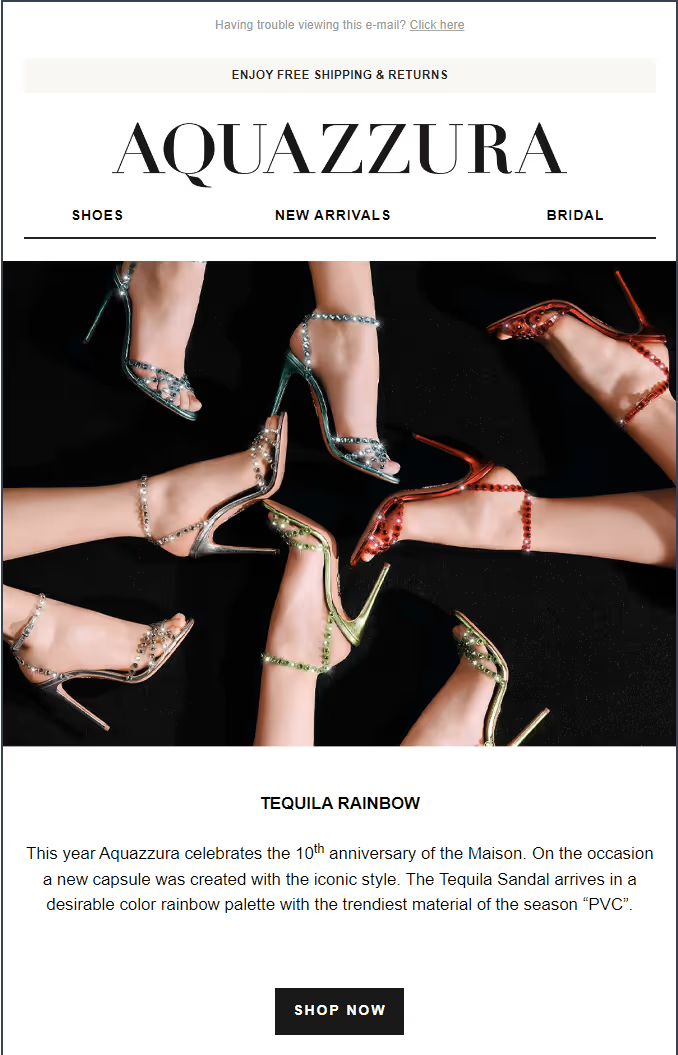
Why use anniversary emails?
Apart from celebrating this special milestone for your brand, anniversary emails let you promote deals that give customers an excuse—ahem, I mean, a reason to shop with you.
You might just see a nice bump in revenue at the end of your anniversary sales as a result. Now that’s a sweet gift.
15. Birthday emails
Don’t celebrate your brand’s birthday without celebrating that of your contacts! Make them feel special by sending an email that acknowledges their big day.
And because birthday celebrations come with birthday treats, include a special promotion for the birthday guy or gal in your birthday email. In Puma’s case, the brand decided to grant a $10 birthday discount on the contact’s next order:
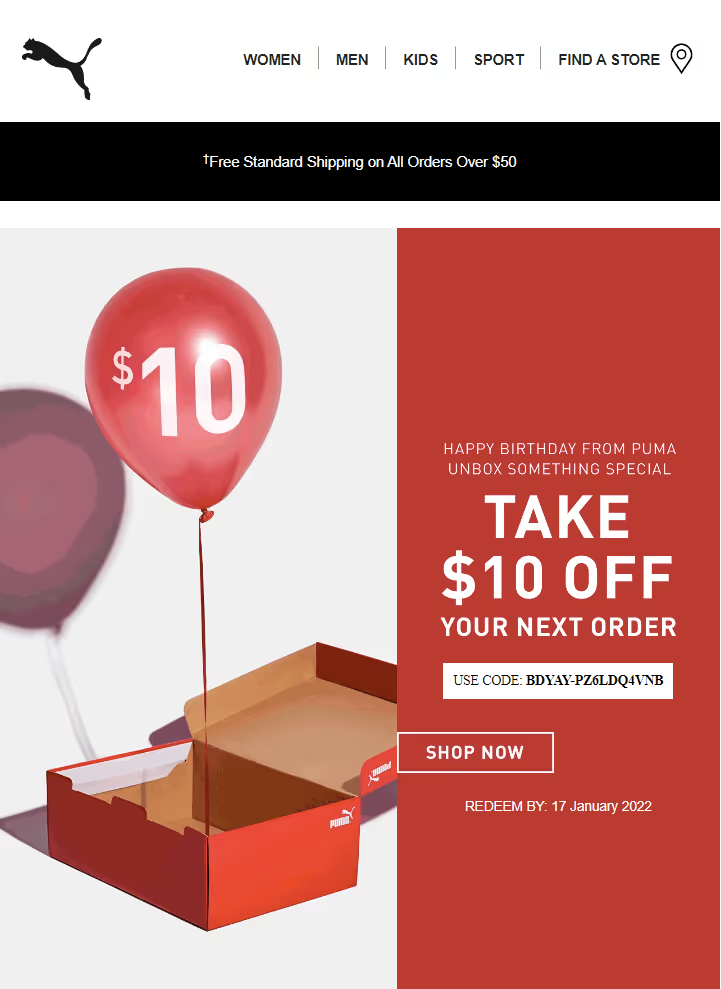
Why use birthday emails?
Birthday emails help you build goodwill with your contacts. That’s because you’ve remembered their birthday—and given them a birthday gift to boot!
What’s more, if the contact claims your birthday deal, you’ll only stand to benefit from higher sales.
How to write creative emails for eCommerce
Use a creative (but clear) CTA
Now that we’ve covered 15 eCommerce email examples you can use for your eCommerce email marketing campaigns, let’s explore how you can add a creative oomph to them!
Here, using creative calls to action (CTAs) is one of our top recommendations for a successful email marketing strategy.
Skip yawn-inducing phrases like “Click Here” and “Go to Store,” and instead craft CTAs that excite your contacts into taking action. Your CTAs should also be crystal-clear on what your contacts should do next.
Try these CTAs in your upcoming eCommerce emails:
- Shop Now
- Claim Your Free Gift
- Check Out Your Cart
Use email automation tools
Email automation tools do the heavy lifting of sending personalized emails at scale. Using them, you’ll have more time and mental energy to write the most creative emails.
For example, our Sendlane email marketing software comes packed with features such as:
- Pre-built automated sales funnels that you can customize to meet your needs—and save time building your funnels from scratch!
- Dynamic content for customizing every email with your contacts’ preferences and shopping behavior.
- Multivariate testing, which is useful for split-testing up to 12(!) different email campaign components and identifying the best-performing combinations. (This includes the testing of novel email copy you’ve just written.)
To give these features a go for yourself, simply claim your free Sendlane trial here.
Personalize the subject line
Tailor your emails’ subject lines to your contacts’ preferences to get them opening and reading your emails. You can personalize your subject lines by:
- Including your contacts’ name in it, such as “We’ve missed you, [Name]!”
- Mentioning your contacts’ interests. For instance, if you run a bedding store, you could use the “Check out the latest deals on pillows!” subject line for contacts who have shown interest in buying a pillow. (And your email body should showcase deals on pillows too, of course.)
Read our guide to email subject lines for eCommerce to learn more best practices for crafting high-performing subject lines.
Segment your email list
Segmenting your email list refers to splitting your list up into different categories based on your contacts’ demographics, interests, and preferences. Doing so lets you personalize your emails with creative copy for each segment of contacts.
If you sell tabletop games, for example, you could use an email service provider like Sendlane to create a segment of board game enthusiasts. After that, you could send just these contacts an email promoting your latest board games.
At the same time, you could create another segment of contacts interested in card games and send them an email chock-full of card game recommendations.
Using Sendlane to segment its email list, Skybound Entertainment was able to increase its open rates to as high as 80%. (Read more about this amazing achievement in our eCommerce email marketing case studies!)
If you’d like to see similar success for your eCommerce business, grab your free Sendlane trial here.
You’ll then be all set to try recreating the 15 best eCommerce email examples we’ve covered in this article, and experiment with Sendlane’s powerful email features for boosting your store revenue!
Want to learn more about eCommerce? Check out our similar posts:
How to Create Personalized Emails for eCommerce
Upsell Emails Best Practices for eCommerce in 2023



%20(1).avif)




%20(1).avif)
%20(1).png)
.avif)


.avif)
.avif)


.avif)





.avif)



.avif)





.avif)


.avif)

.avif)
.avif)

.avif)
.avif)

.avif)

.avif)


.avif)
.avif)
%20(1).avif)
.avif)









.avif)











.avif)
.avif)

%20(1).avif)

%20(1).avif)



.avif)


























.avif)











































.avif)



.avif)




























.avif)



.avif)

.avif)

.avif)
.avif)


.avif)













.avif)

.avif)










.avif)












.avif)






































.avif)



.avif)

.avif)

.avif)
.avif)

.avif)
.avif)

.avif)

.avif)

.avif)

























